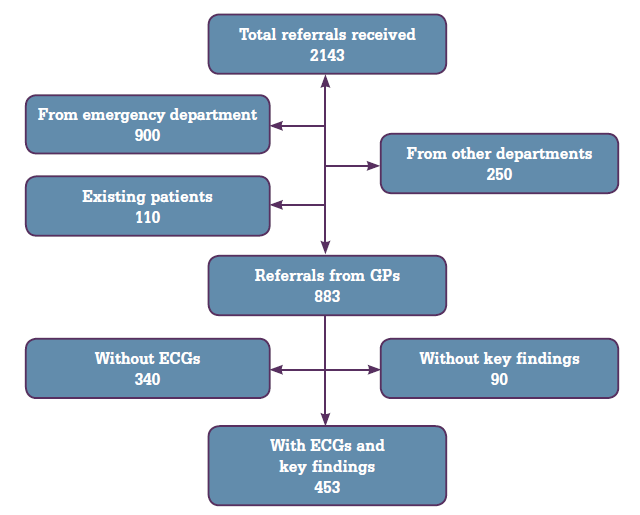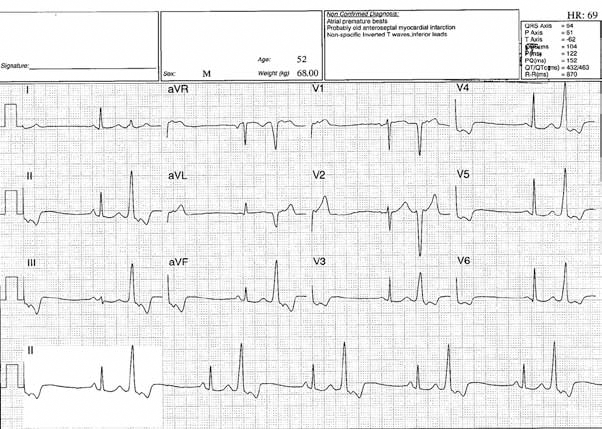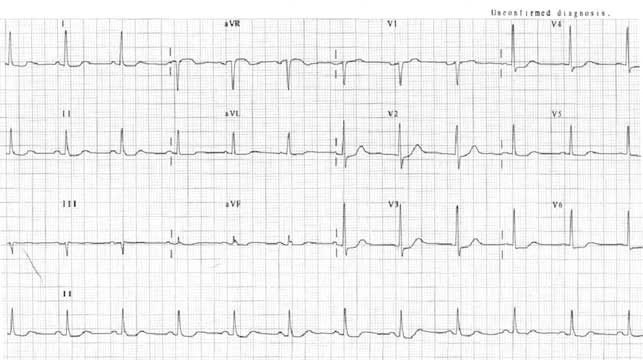This study aimed to retrospectively assess the accuracy of key findings on the ECG by GPs based on subsequent referrals to cardiology clinics at a public hospital. The previously unreported topic of appropriateness of referrals to cardiology clinics of patients with ECGs compared to those without ECGs was also assessed.
Methods
The study sample came from Logan Hospital, a medium sized public hospital in southeast Queensland. It consisted of all patient referrals from GPs directly to the cardiology clinic or to the hospital emergency department and subsequently referred on to the cardiology clinic between 1 January 2007 and 31 December 2009. Patients from internal hospital referrals and existing patients receiving follow up were excluded. The symptom status of referrals with ECGs was compared with referrals without ECGs. In referrals with ECGs, the ECG diagnosis of the GP, and where available, the interpretive function of the ECG machine, was compared with a reference standard of the ECG diagnosis made by the cardiologist reviewing the patient. If an ECG was given more than one diagnosis by the GP, the interpretive function or the cardiologist, the clinically more serious diagnosis as selected by the cardiologist was chosen as the index diagnosis, eg. if both isolated ventricular ectopic beats and left bundle branch block (LBBB) were diagnosed, LBBB was selected. A random sample of 10% of the ECGs was evaluated by an ECG specialist in order to determine the interobserver agreement on the reference diagnosis.
Ethics approval for this study was granted by the Princess Alexandra Hospital Human Research Ethics Committee on 25 June 2010.
Analysis
Data were entered into Microsoft Access and Excel databases (Microsoft; 2003). The accuracy of GP key findings and interpretive function key findings was calculated as the percentage agreement with the cardiologists key findings. Categorical data were analysed using Fisher's exact test or Chi-square depending on sample size. Interobserver agreement between the cardiologist and the ECG specialist was calculated using Kappa values.
Results
During the sampling period a total of 2143 referrals were sent from 292 GPs at 111 different practices (Figure 1). The mean (standard deviation [SD]) age of the patients was 57 (14) years, range 17–92 years; 52.4% were males. The main reason for referral was chest pain (43.4%) (Table 1). Three hundred and forty (38.5%) of these referrals were sent without an ECG being performed at the general practice. In 90 (10.2%) referrals, ECGs came with no key findings, and in 453 referrals there were ECGs with key findings available for analysis.
Compared with patients who were asymptomatic at the time of GP consultation, symptomatic patients were more likely to have an ECG performed than those who were asymptomatic (p<0.001). Symptomatic patients without ECGs were more likely to be sent by ambulance directly to the hospital (p<0.001). An average of 2.13 (3.5) cardiovascular risk factors per patient were noted by GPs in the referral letter, the most common factor being hypertension (55.6%). Neither the presence nor the number of risk factors was associated with the presence of an ECG with the referral.
The agreement on key findings between the GPs and the cardiologists was 58.9%. Data on the interpretive function on the ECG machine was available in 63 ECGs (13.4%). The agreement on key findings between the interpretive function and the cardiologists was 44.4%. Figure 2 demonstrates an inaccurate key finding. For key findings, there was no association between the cardiologists and the interpretive function (p=0.29), but there was a significant association between interpretive function and GPs (p<0.001). Of the 186 ECGs that were deemed to have incorrect key findings, 108 (58%) brought no change to the management or outcome of the patient (p<0.001) as determined at 12 month follow up. In a further 69 (37%), the GP made a more serious diagnosis than the cardiologist with no subsequent change in patient management (p<0.001). Nine (5%) were found to have conditions altering management beyond the key findings presented by the GP (p<0.001). Five were the onset of new atrial fibrillation (AF); two were called AF but were in fact atrial flutter requiring subsequent catheter ablation; one displayed ST segment depression, diagnosed as normal by the GP, which was subsequently diagnosed as a non-ST segment myocardial infarction (non-STEMI) (Figure 3). In the remaining referral, a new LBBB was missed and latter diagnosed as inferior myocardial ischaemia by dobutamine stress echocardiography.
Interobserver agreement between the cardiologist and the ECG specialist from the random sample of ECGs was 94% with a Kappa value of 0.848 (95% confidence interval [CI]: 0.704–0.991) indicating very good agreement.

Figure 1. Study sampling frame
Table 1. Main reason for referral to cardiology clinic
| Reason for referral | N | % |
|---|
| Chest pain |
383 |
43.4 |
| Palpitations |
70 |
7.9 |
| Shortness of breath |
68 |
7.7 |
| Review |
65 |
7.4 |
| ECG changes |
52 |
5.9 |
| Dizziness |
41 |
4.6 |
| Other |
36 |
4.1 |
| Exertional shortness of breath |
28 |
3.2 |
| Positive exercise stress test |
26 |
2.9 |
| Chest tightness |
20 |
2.3 |
| Hypertension |
19 |
2.2 |
| Syncope |
15 |
1.7 |
| Murmur |
14 |
1.6 |
| Heart failure |
13 |
1.5 |
| Fatigue |
13 |
1.5 |
| Chest heaviness |
11 |
1.3 |
| Light headedness |
7 |
0.8 |
| Anxiety |
2 |
0.2 |
| Total |
883 |
100 |

Figure 2. ECG from a general practitioner. The GP described this a ST segment depression, interpretive function determined the key finding to be atrial premature beats and the cardiologist diagnosed ventricular bigeminy

Figure 3. ECG with ST segment depression in leads V3–V6, I, II and reciprocal elevation in aVR. This ECG was described as normal by the GP
Discussion
At 58.9%, the level of agreement between the GPs and the cardiologists key findings assessed retrospectively was modest. This is 5–10% lower than that reported in studies where GPs knew they were being tested or interpretive recorders were used.3–5 The modest level of agreement seen in this study could be attributed to the large number of patients with undifferentiated disease that GPs must filter in order to determine whether or not a referral is warranted. The result is a lower predictive value in those referred to a cardiology clinic in order to maximise accuracy in those patients with significant disease ensuring they are not missed.7 Indeed, the current study demonstrated this with 37% of the incorrect key findings falling into this category. At 44.4%, the interpretive function showed considerably less agreement for the key findings; however minor findings were not assessed. The low level of agreement for the interpretive function was similar to that found in the setting of myocardial infarction.8–9 The significant association between the interpretive function and the key findings of the GPs suggest an influence of the interpretive function on GP diagnosis. With exclusion of these ECGs from analysis, the level of agreement for the GPs key findings increases to 62.2%, suggesting a negative influence of the interpretive function on GP diagnosis.
Despite the modest level of agreement for key findings between the GPs and the cardiologists, the majority of symptomatic patients in this sample were appropriately referred directly to hospital, irrespective of the key findings; some without ECGs. Many factors influence what constitutes an appropriate referral, making the judgement of appropriateness a complex decision.10 There are studies demonstrating the existence of both appropriate and inappropriate referrals to specialist clinics by GPs,11–12 however the rate of under-referral is considered very low.11 This provides reassurance that patients requiring further investigation are not missed. In all nine cases with missed key findings resulting in a change in management, the GPs referred based on clinical acumen, highlighting the excellent gatekeeping ability of the GPs.
A substantial proportion (38.5%) of referrals were made without a general practice ECG. The reasons for this were not defined by this study, but in those who were symptomatic and sent to hospital by ambulance, it may have been influenced by an expectation that the ambulance officers would perform an ECG. Indeed in all such patients an ambulance officer recorded an ECG.
Limitations of this study
There are some limitations to this study. The referrals we assessed were to the cardiology clinic at one hospital and so may not reflect other hospitals. Due to the retrospective nature of the current study an assessment of the ECGs performed on patients who were not referred to the cardiology clinic cannot be made. Likewise an assessment cannot be made on patients seen by GPs who did not have ECGs or cardiology clinic referral when they may have been clinically indicated.
Conclusion
Although we found agreement between the GPs and cardiologists key ECG findings to be modest, the ability of GPs to appropriately refer based on clinical presentation was exceptional and emphasises their outstanding analytical capabilities in this study. Based on our findings the interpretive function on ECG machines should be viewed with extreme caution, particularly when using this to diagnose key findings.
Conflict of interest: none declared.
Acknowledgements
This article was written with funding support from the Griffith University Primary Health Care Research Evaluation and Development (PHCRED) program, which is funded by the Australian Government Department of Health and Ageing.